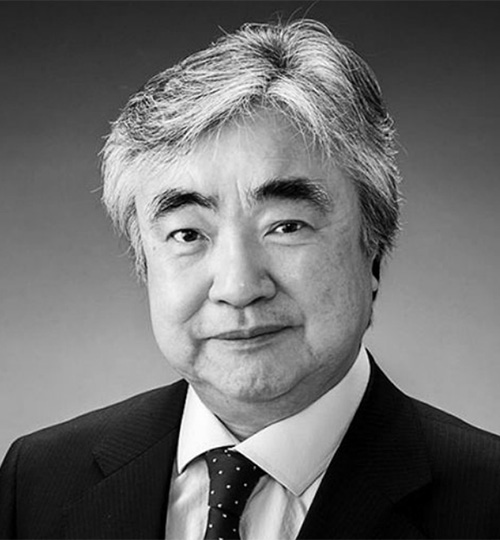 Professor Oishi graduated from the Department of Electronics and Communication, Faculty of Science and Engineering, Waseda University, in March 1976. He completed his doctorate in the Department of Electric Engineering at Graduate School of Science and Engineering of the same university and received a Ph.D. in 1981. He became an assistant in April 1980, a lecturer in June 1982, an associate professor in April 1984, and a professor in April 1989 at the same university. He was the dean of the School and Graduate School of Fundamental Science and Engineering, Faculty of Science and Engineering, from September 2010 to September 2014, and was the senior dean of the Faculty of Science and Engineering, from September 2014 to September 2016 at the same university.
Professor Oishi graduated from the Department of Electronics and Communication, Faculty of Science and Engineering, Waseda University, in March 1976. He completed his doctorate in the Department of Electric Engineering at Graduate School of Science and Engineering of the same university and received a Ph.D. in 1981. He became an assistant in April 1980, a lecturer in June 1982, an associate professor in April 1984, and a professor in April 1989 at the same university. He was the dean of the School and Graduate School of Fundamental Science and Engineering, Faculty of Science and Engineering, from September 2010 to September 2014, and was the senior dean of the Faculty of Science and Engineering, from September 2014 to September 2016 at the same university.Throughout his career, professor Oishi has engaged in research on mathematics for electronics, information and communication theories, including, in particular, nonlinear theory, such as soliton and nonlinear analysis, and its applications, and numerical calculation with guaranteed accuracy. He has also devoted himself to student education, and developed many excellent researchers and engineers working actively in academia and industry.
Professor Oishifs main research achievements can be summarized as follows:
(1) Using a method of numerical calculation with guaranteed accuracy, he developed computer assisted methods of proving the existence and local uniqueness of solutions to various nonlinear problems and giving precise inclusion of solutions.
(2) Especially using a verified numerical calculation, he developed a method of verifying the existence of a solution to a boundary value problem for a nonlinear ordinary, delay differential, and partial differential equations. As one of applications, he demonstrated that this can be used to prove homoclinic bifurcation in nonlinear dynamical systems. He thus demonstrated the usefulness of computer-assisted proof methods that use numerical calculation with guaranteed accuracy for nonlinear problems such as dynamical systems.
(3) He invented an interval arithmetic at the matrix level via controlling rounding modes defined in IEEE 758 for guaranteeing accuracy of numerical solutions for various problems in numerical linear algebra, and demonstrated that a verified numerical calculation forms the basis of numerical calculation, the purpose of which is to obtain a correct result at high speed. It became clear that this method can guarantee the accuracy of a solution to various problems in numerical linear algebra with a computational cost only a few times higher than that needed for obtaining an approximate solution. As a result, hereafter the method of numerical calculation with guaranteed accuracy began to be used for practical purposes.
(4) He introduced a concept of error-free transformation, and developed a high-speed reversible numerical calculation method, which automatically and adaptively changes calculation accuracy and does a rapid calculation up to the required number of digits. This proved that numerical calculation libraries can be improved to do calculations rapidly and correctly up to the required number of digits. This made it possible to establish a design method for error-controlled numerical algorithms with rich engineering applications.
(5) He developed a method of calculating the lower bound of an eigenvalue of an elliptic partial differential eigenvalue problems. This is an effective method applicable to a wide range of problems that use the finite element method and forms the basis for methods of calculating solutions to linear and nonlinear partial differential equations with guaranteed accuracy.
(6) It is often difficult to find a solution to a nonlinear problem analytically. In the electronics, information and communication field, nonlinear problems appear in a variety of situations including chaos and solitons. Professor Oishi established a field of study in which a computer-assisted proof method based on numerical calculation with guaranteed accuracy is used to analyze these problems.
In recognition of these achievements, he has received numerous science awards, including Best Paper Award, Inose Award, and Achievement Award from IEICE, the Ministerfs Award in Science and Technology from the Ministry of Education, Culture, Sports, Science and Technology, and Medal with Purple Ribbon. He was designated a fellow by IEICE, Japan Society of Industrial and Applied Mathematics, and Japan Society for Simulation Technology.
Professor Oishi served in important posts in IEICE, including vice president of IEICE, president of the Engineering Sciences Society, editor-in-chief of NOLTA, IEICE, director of Publications, and chair of the Technical Committee on Nonlinear Problems. He was involved in the establishment of the NOLTA Symposium, an international conference on nonlinear theory and its applications and has grown it into a globally known conference. He served as a member of the Science and Engineering Committee, and the HPCI Promotion Committee, both under the Ministry of Education, Culture, Sports, Science and Technology. While he was the dean and the senior dean of the Faculty of Fundamental Science and Engineering, Waseda University, he was instrumental in the establishment of the Department of Information and Communication, and of the research institutes related to information and communication.
As described above, his contributions in the electronics, information and communication field have been outstanding, and we are convinced that he fully deserves to be a recipient of the Distinguished Achievement and Contributions Award.